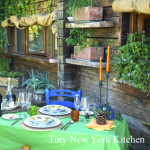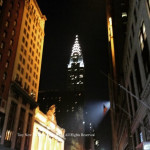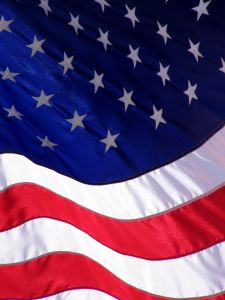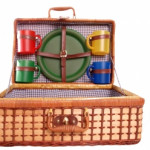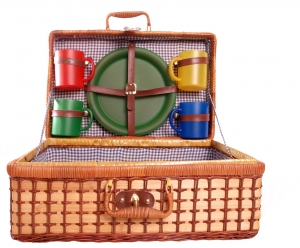If you’re preparing for an outdoor party or get-together set the stage ahead of time by purchasing disposable plates, cups, silverware, and napkins. Make sure to have trash bags, paper towels, and cleaning supplies on hand. Clear off the counters and dishwasher in advance, so you have an open work space. If you’re dining al fresco for two then, by all means, use real dishes.
During your party or get-together make sure to leave trash and recycling bins accessible to guests. Because you’re unable to monitor everything, recruit a few people to help you take charge of specific tasks like replenishing drinks and periodically clearing away trash.
For cleanup use large trays for transporting food and supplies back to the house. Pack up leftovers, using resealable bags instead of more bulky plastic containers. Soak pots, pans, grill tools, and dishes to make them easier to clean. Designate a family member to clean one section of the yard.
“Work With What You Got!”
© Victoria Hart Glavin Tiny New York Kitchen © 2017 All Rights Reserved
Labor Day History
New York, New Jersey and Colorado were among the first states to approve state legal holidays. In response to support for a national holiday, Sen. James Henderson Kyle of South Dakota introduced a bill to make Labor Day a legal holiday on the first Monday of September each year. It was approved June 28, 1894.
Labor Day, the first Monday in September, is a creation of the labor movement and is dedicated to the social and economic achievements of American workers. It celebrates a yearly national tribute to the contributions workers have made to the strength and prosperity of the United States of America.
Through the years the nation have given increasing emphasis to Labor Day. The first governmental recognition came through municipal ordinances passed during 1885 and 1886. From these, a movement developed to secure state legislation. The first state bill was introduced into the New York legislature, but the first to become law was passed by Oregon on February 21, 1887. During that year four more states (Colorado, Massachusetts, New Jersey, and New York) created the Labor Day holiday by legislative enactment. By the end of the decade Connecticut, Nebraska, and Pennsylvania had followed suit. By 1894, twenty-three other states had adopted the holiday in honor of workers. On June 28th of that year, Congressed passed an act making the first Monday in September of each year a legal holiday in the District of Columbia and the territories.
More than 100 years after the first Labor Day observance, there is still some doubt as to who first proposed Labor Day. Some records indicate that Peter J. McGuire, general secretary of the Brotherhood of Carpenters and Joiners and a cofounder of the American Federation of Labor, was first in suggesting a day to honor those “who from rude nature have delved and carved all the grandeur we behold.” But, Peter McGuire’s place in Labor Day history has not gone unchallenged. Many believe that Mathew Maguire, a machinist, founded the holiday. Recent research seems to support the contention that Mathew Maguire, later the secretary of Local 344 of the International Association of Machinists in Patterson, New Jersey, proposed the holiday in 1882 while serving as secretary of the Central Labor Union in New York. What is clear, however, is that the Central Labor Union adapted a Labor Day proposal and appointed a committee to plan a demonstration and picnic.
The first Labor Day holiday was celebrated on Tuesday, September 5, 1882, in New York City, in accordance with the plans of the Central Labor Union. The Central Labor Union held its second Labor Day holiday just a year later, on September 5, 1883.
In 1884 the first Monday in September was selected as the holiday, as originally proposed, and the Central Labor Union urged similar organizations in other cities to follow the example of New York and celebrate a “workingmen’s holiday” on that date. The idea spread with the growth of labor organizations, and in 1885 Labor Day was celebrated in many individual centers of the country.
The form that the observance and celebration of Labor Day should take was outlined in the first proposal of the holiday, which was a street parade to exhibit to the public “the strength and espirit de corps of the trade and labor organizations” of the community, followed by a festival for the recreation and amusement of the workers and their families. This became the pattern for the celebrations of Labor Day. Speeches by prominent men and women were introduced later, as more emphasis was placed upon the economic and civic significance of the holiday. Still later, by a resolution of the American Federation of Labor convention of 1909, the Sunday preceding Labor Day was adopted as Labor Sunday and dedicated to the spiritual and educational aspects of the labor movement.
The character of the Labor Day celebration has undergone a change in recent years, especially in large industrial centers where mass displays and huge parades have proven to be a problem. This change, however, is more a shift in emphasis and medium of expression. Labor Day addresses by leading union officials, industrialists, educators, clerics, and government officials are given wide coverage in newspapers, radio, and television.
The vital force of labor added materially to the highest standard of living and the greatest production the world has ever known and has brought us closer to the realization of our traditional ideals of economic and political democracy. It is appropriate, therefore, that the nation pay tribute on Labor Day to the creator of so much of the nation’s strength, freedom, and leadership – The American Worker!
“Work With What You Got!”
© Victoria Hart Glavin Tiny New York Kitchen © 2015 All Rights Reserved
Living is New York City is a wonderful thing. The city is never boring and always vibrant, but living in the city is also tiring. By the end of the week I’m usually pretty tired and am in need of a major weekend rest. Last night I had a meeting to go to and then had planned to leave for my weekend home in Connecticut for a long Labor Day weekend. Walking home from my meeting last night I was crossing 42nd Street and saw that the Chrysler Building was beautifully lit. While taking this photo I reflected on how grateful I am to have the best of both worlds and how I was soon heading to my house for a much needed break. Blessing to all of you!
Labor Day is over and it’s school time again. Many school aged children skip breakfast on a daily basis because of either financial reasons or because of the morning rush to get to school on time. Studies show that children, as well as college students, who eat breakfast have better math scores, less tardiness, less hyperactivity and better overall school attendance than those children who don’t eat breakfast. If you want your student to be more alert, focused and ready to tackle the day’s academic challenges then encourage them to eat breakfast daily and not just on test days. Eating a nutritious breakfast will help your child concentrate, behave and learn. Studies have shown that eating breakfast improves a student’s classroom performance, including better test scores and better grades. It is important for a student to be able to concentrate on his or her school work as well as learning positive habits that will carry over into adulthood. Eating breakfast can do more than just keep your child full!

